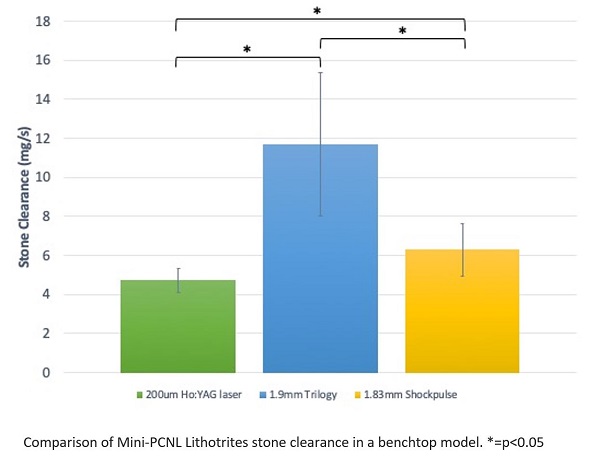Back
Poster, Podium & Video Sessions
Moderated Poster
MP32: Surgical Technology & Simulation: Instrumentation & Technology I
MP32-05: Benchtop Evaluation of Miniature Percutaneous Nephrolithitomy Lithotrites
Saturday, May 14, 2022
2:45 PM – 4:00 PM
Location: Room 225
Patrick Whelan, Christopher Kim, Christian Tabib*, Durham, NC, Russell Terry, Gainesville, FL, Glenn Preminger, Michael Lipkin, Durham, NC
- CT
Christian H. Tabib, MD
Duke University
Poster Presenter(s)
Introduction: Percutaneous nephrolithotomy (PCNL) is the preferred surgical treatment for kidney stones >2cm. While PCNL has traditionally been performed using access sheaths from 24-30Fr in size, there is presently a trend toward using increasingly smaller sheaths ( <20Fr) and scopes to perform what has been termed “mini-PCNL.” Smaller mechanical lithotripsy instruments have therefore been developed for this purpose, but are limited in comparative effectiveness. We performed benchtop assessment of multiple mini-PCNL lithotrites.
Methods: One 1cm3, hard Begostone phantom, mimicking a calcium oxalate monohydrate stone, was placed in a cylinder with four 5.5mm cylindrical openings to simulate size of a 16.5Fr mini-PCNL sheath to drain via Venturi effect. Lithotripsy was then performed with either the 1.9mm Trilogy (EMS), 1.83mm ShockPulse (SP, Olympus) and 200mm Holmium:YAG laser. Suction was used for the mechanical lithotrites. The Trilogy probes were used at 50% impact, 6Hz, 80% ultrasound and 10% suction. The ShockPulse was used at high-power setting. The 1.9mm probe was used with a 15Fr mini nephroscope (Olympus). The ShockPulse, 1.5mm Trilogy and laser fiber were used with a 12Fr mini nephroscope (Karl-Storz). The laser was set at 0.5J/70Hz Moses-Distance (MD) (Lumenis). 10 independent runs were performed with each probe. Time to complete stone clearance was recorded and mass stone clearance rates were calculated.
Results: The Trilogy 1.9mm probe showed superior stone clearance rate (11.69 ± 3.68 mg/s) vs the SP 1.83mm probe (6.29 ± 1.37 mg/s, p=0.003) and the laser fiber (4.73 ± 0.61 mg/s, p<0.0005), respectively (Figure 1). The SP was also superior to the laser (p=0.016). This translates to 4.6 and 7.9 minutes less treatment time vs the SP and laser, respectively, for a spherical 1.5cm diameter calcium oxalate monohydrate stone.
Conclusions: Among these three commonly used mini-PCNL probes, the Trilogy 1.9 demonstrated clearly superior stone clearance rates in this benchtop model. This could be due to improved lithotrite properties and use of suction evacuation, especially compared to the laser. Future clinical testing is warranted to evaluate optimal lithotrite for miniPCNL.
Source of Funding: Boston Scientific provided funding for this study through an educational grant

Methods: One 1cm3, hard Begostone phantom, mimicking a calcium oxalate monohydrate stone, was placed in a cylinder with four 5.5mm cylindrical openings to simulate size of a 16.5Fr mini-PCNL sheath to drain via Venturi effect. Lithotripsy was then performed with either the 1.9mm Trilogy (EMS), 1.83mm ShockPulse (SP, Olympus) and 200mm Holmium:YAG laser. Suction was used for the mechanical lithotrites. The Trilogy probes were used at 50% impact, 6Hz, 80% ultrasound and 10% suction. The ShockPulse was used at high-power setting. The 1.9mm probe was used with a 15Fr mini nephroscope (Olympus). The ShockPulse, 1.5mm Trilogy and laser fiber were used with a 12Fr mini nephroscope (Karl-Storz). The laser was set at 0.5J/70Hz Moses-Distance (MD) (Lumenis). 10 independent runs were performed with each probe. Time to complete stone clearance was recorded and mass stone clearance rates were calculated.
Results: The Trilogy 1.9mm probe showed superior stone clearance rate (11.69 ± 3.68 mg/s) vs the SP 1.83mm probe (6.29 ± 1.37 mg/s, p=0.003) and the laser fiber (4.73 ± 0.61 mg/s, p<0.0005), respectively (Figure 1). The SP was also superior to the laser (p=0.016). This translates to 4.6 and 7.9 minutes less treatment time vs the SP and laser, respectively, for a spherical 1.5cm diameter calcium oxalate monohydrate stone.
Conclusions: Among these three commonly used mini-PCNL probes, the Trilogy 1.9 demonstrated clearly superior stone clearance rates in this benchtop model. This could be due to improved lithotrite properties and use of suction evacuation, especially compared to the laser. Future clinical testing is warranted to evaluate optimal lithotrite for miniPCNL.
Source of Funding: Boston Scientific provided funding for this study through an educational grant

.jpg)
.jpg)